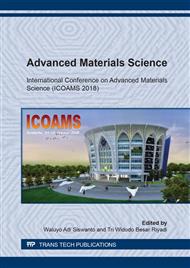[1]
S. B. Wang, X. F. Chang, and J. Key, New insight into high-temperature creep deformation and fracture of T92 steel involving precipitates, dislocations and nanovoids,, Mater. Charact., vol. 127, p.1–11, (2017).
DOI: 10.1016/j.matchar.2017.01.025
Google Scholar
[2]
J. Brnic, G. Turkalj, M. Canadija, and D. Lanc, Creep behavior of high-strength low-alloy steel at elevated temperatures,, Mater. Sci. Eng. A, vol. 499, no. 1–2, p.23–27, (2009).
DOI: 10.1016/j.msea.2007.08.102
Google Scholar
[3]
G. S. Tibba and H. Altenbach, Modelling Creep Behaviour of Superheater Materials,, Energy Procedia, vol. 93, no. March, p.197–202, (2016).
DOI: 10.1016/j.egypro.2016.07.170
Google Scholar
[4]
S. Chaudhuri and R. N. Ghosh, Creep behavior of 2.25Cr1Mo steel-Effects of thermal ageing and pre-strain,, Mater. Sci. Eng. A, vol. 510–511, no. C, p.136–141, (2009).
DOI: 10.1016/j.msea.2008.04.108
Google Scholar
[5]
S. Nandi, G. J. Reddy, and K. Singh, Microstructural changes in IN617 superalloy during creep at high temperatures,, Procedia Eng., vol. 86, p.66–70, (2014).
DOI: 10.1016/j.proeng.2014.11.012
Google Scholar
[6]
Y. Chen et al., Creep behaviors and microstructure analysis of CNS-2 steel at elevated temperatures and stresses,, J. Nucl. Mater., vol. 495, p.306–313, (2017).
DOI: 10.1016/j.jnucmat.2017.08.003
Google Scholar
[7]
T. H. Kim and Y. S. Chang, Numerical Study on Creep Rupture Behavior of SA533B Low-Alloy Steel,, Procedia Eng., vol. 130, p.1755–1760, (2015).
DOI: 10.1016/j.proeng.2015.12.205
Google Scholar
[8]
M. Cowan and K. Khandelwal, Modeling of high temperature creep in ASTM A992 structural steels,, Eng. Struct., vol. 80, p.426–434, (2014).
DOI: 10.1016/j.engstruct.2014.09.020
Google Scholar
[9]
S. Hore and R. N. Ghosh, Computer simulation of the high temperature creep behaviour of Cr-Mo steels,, Mater. Sci. Eng. A, vol. 528, no. 19–20, p.6095–6102, (2011).
DOI: 10.1016/j.msea.2011.04.050
Google Scholar
[10]
T. Massé and Y. Lejeail, Creep behaviour and failure modelling of modified 9Cr1Mo steel,, Nucl. Eng. Des., vol. 246, p.220–232, (2012).
DOI: 10.1016/j.nucengdes.2012.02.006
Google Scholar
[11]
L. Kloc, P. Dymáček, and V. Sklenička, High temperature creep of Sanicro 25 austenitic steel at low stresses,, Mater. Sci. Eng. A, vol. 722, p.88–92, (2018).
DOI: 10.1016/j.msea.2018.02.095
Google Scholar
[12]
W. L. Oberkampf and M. F. Barone, Measures of agreement between computation and experiment: Validation metrics,, J. Comput. Phys., vol. 217, no. 1, p.5–36, (2006).
DOI: 10.1016/j.jcp.2006.03.037
Google Scholar


